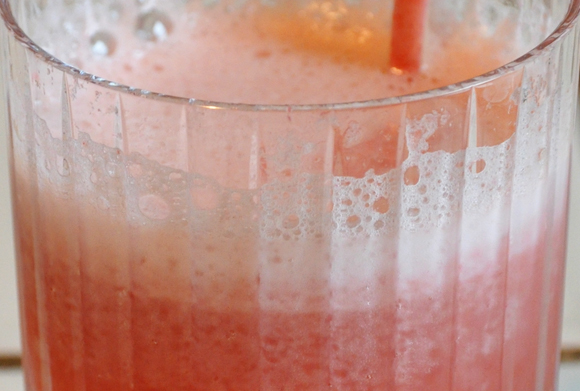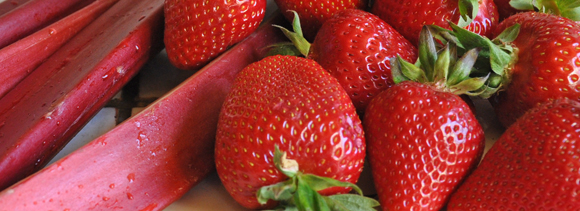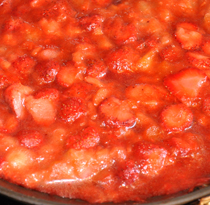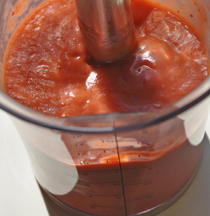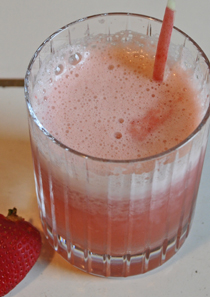May 18, 2024. Back in the Better Cheaper Soda Lab again. Still looking for that magic flavor combination that will convert each and every cola addict to a healthy soda pop drinker.
Today I have a special mission. Delicious all-natural soda with no sodium. Zero added sugar. Low glycemic load. Here it is. If your only requirement is great flavor, this one’s for you, too. If you’re on a low-sodium diet, you have to try this. But please don’t sprinkle any of the Gremolata Powder salt substitute on this already delicious soda.
Ingredients
For 9 tablespoons of concentrated flavor base
1 cup of rhubarb, peeled and sliced
1-1/2 cups of strawberries, cored and sliced
Strawberry-Rhubarb Soda Pop
Cook the rhubarb for 10 minutes over medium-low heat in a non-stick pan. The rhubarb goes from crisp to very soft. Then add the strawberries, right on top so their juices run down onto the relatively drier rhubarb. After 4 or 5 minutes, the strawberries are very soft. And you begin to get a very strong whiff of very sweet strawberry. The cookings done.
Now put your fruit into your food processor and press play. You should have a very smooth puree in less than a minute. Put it into the fridge to chill.
Finally, play around with the amount of seltzer you use – that is, how much you’re going to dilute the sweet fruit flavor base with water. Do you want a sweet carbonated drink – or just a flavored sparkling water? For me, two tablespoons of the fruit puree and 8-ounces of seltzer makes a very flavorful sparkling beverage. Three tablespoons of the ripe fruit puree brings it into soda pop territory.
Sweet stuff
Just how sweet is up to you and your tongue. Here are some things you and your brain should know.
People who swallow one or more sugary soft drinks per day double their risk for obesity, Type 2 diabetes and heart disease.
People who drink this stuff regularly are at the same higher risk for diabetes and heart disease even when they maintain a healthy diet and healthy weight. So, yes, drinking a lot of sugar is likely to put on pounds. But even if it doesn’t, the effects of drinking high glycemic load sodas will still get you. Because it causes a sudden spike in blood sugar. The sugars in whole fruit don’t cause this because they have as much fiber as sugar. Which slows down their metabolism and prevents spikes.
Glycemic Load? First, there’s the ingredient’s Glycemic Index (GI): how quickly a fixed amount of it, say a gram, boosts your blood sugar. Then there’s Glycemic Load (GL): how much of it is there to do the boosting.
Ripe strawberries taste really sweet. But their simple fruit sugar combined with their natural fiber has a minimal effect on your blood sugar level. Three tablespoons of the pure fruit puree has a GL of less than 2.
Health Cost Comparison
Now look at Coca-Cola and its sweetener: high fructose corn syrup. Coca Cola’s Glycemic Index is 68; an 8-ounce serving delivers a Glycemic Load of 16. 8 times higher than your naturally very sweet fruit soda pop. And it’s got more sodium than you want to be drinking. Diet Coke has even more.
Calories in an 8-ounce serving? Coke: 97. Your Strawberry-Rhubarb Pop: 24. One-fourth of Coke’s.
Out-of-pocket cost? This one’s a toss-up, because strawberries are pretty expensive. An 8-ounce serving of mine costs about 60 cents with organic Farmers Market berries. But just 35 cents when I buy a big carton of strawberries at Costco. An 8-oz can of Coke is about 62 cents in my neighborhood.
What to do?
Make and drink your own soda. Low GI and Low GL means no adverse effect on your metabolism. If your doctor tells you to cut out sodium, well, you pretty much have to make your own. It can be Cheaper than buying a cola. And much Better and Cheaper than paying for drugs and hospital bills.
Sure, you could just eat some fruit and drink a glass of water. That would be Perfect Cheaper Slower. But I’m into Better because you’re much more likely to do it. So if you – or someone you know – is swallowing a lot of that canned and bottled stuff, try this instead. Cheers!
Cost Comparison
Water. Seltzer. Soda.
Let’s start with tap water vs. bottled water. Drinking bottled water has an environmental impact 285 times greater than drinking tap water. It’s the greenhouse gas emissions associated with making and transporting all those plastic bottles. Your personal out-of-pocket cost? Well, tap water’s practically free; bottled water, not close to free. Water quality? Get a good filter – your drinking water will be better than most bottled waters.
Want bubbles?
Blow your own. Get a soda siphon; fill it with your filtered tap water; carbonate it with a small, cheap, recyclable carbon dioxide cartridge. The freshest and best sparkling water in town.
Every Thing Is Everything
Make your own soda and you can dramatically improve your health, save money and save planetary wear and tear.
The CDC notes, “Since the mid-seventies, the prevalence of overweight and obesity has increased sharply for both adults and children.”
Well, what’s changed since the 1970s? The American Journal of Preventive Medicine tells us, “For all age groups, sweetened beverage consumption increased and milk consumption decreased. Overall, energy intake from sweetened beverages increased 135% and was reduced by 38% from milk, with a 278 total [daily] calorie increase.”
The U.S. Dept. of Agriculture’s Economic Research Service looked at just fifteen years and found “A big jump in average calorie intake between 1985 and 2000 … Of that 300-calorie increase, grains (mainly refined grains [especially corn for HFCS]) accounted for 46 percent; added sugars, 23 percent ”.
Most of the daily calorie increase came from food products – largely colas, sodas and other drinks – based on high-fructose corn syrup.
